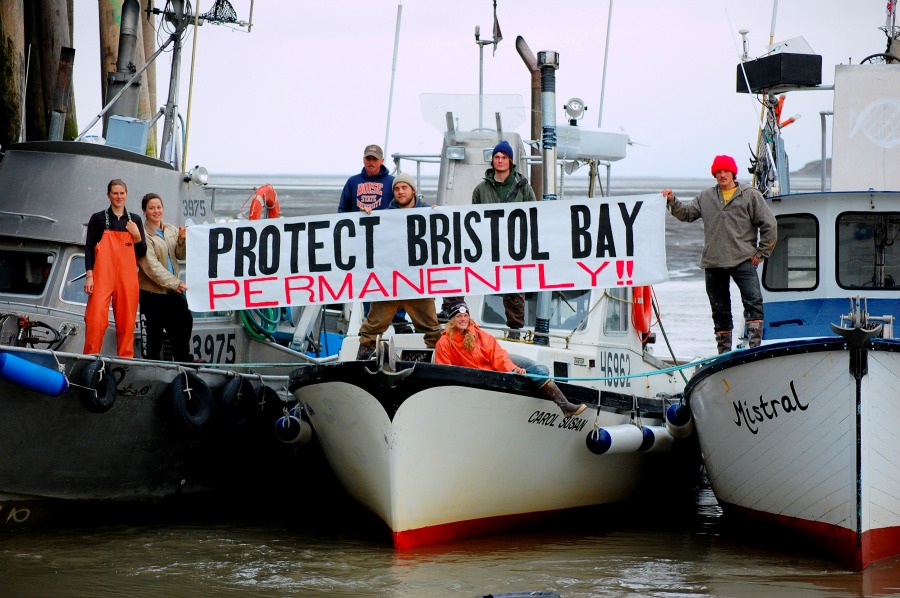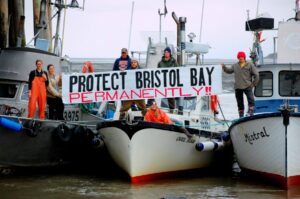
EPA Cleared of any Wrongdoing for Bristol Bay Watershed Assessment
Last month, the Office of Inspector General (OIG) released a report on its investigation into the Environmental Protection Agency’s (EPA) conduct while preparing the Bristol Bay Watershed Assessment—the scientific report that the agency conducted to determine if the environmental risks posed by the proposed Pebble Mine were just too high. OIG “found no evidence of bias in how the EPA conducted its assessment of the Bristol Bay watershed, or that the EPA predetermined the assessment outcome.” Pebble Limited Partnership (Pebble) has been dragging EPA’s name through the mud for the past few years and this report begins to expose Pebble’s attacks for what they are: a desperate attempt to keep the mine prospect alive.

Commercial fishermen display their feelings about the proposed Pebble Mine in 2010. Photo by Luke Strickland.
The threat from the proposed Pebble mine has been hanging over the Bristol Bay region for decades. After years of expressing their concerns to State officials to no avail, communities in the region began to reach out to EPA for help. In May 2010, six federally recognized tribal governments sent a petition to EPA requesting that the agency start a process under Section 404(c) of the Clean Water Act (CWA). The 404(c) provision allows EPA to restrict or prohibit certain normally permittable activity within a particular area if a project will have unacceptable adverse impacts on water, wildlife, or recreational resources. The 404(c) process is often referred to as EPA’s veto authority because permits cannot be issued when there is an unacceptable adverse impact. The 404(c) authority is not something that EPA takes lightly and the agency has only used this provision 13 times since 1972.
In 2010, EPA initiated a scientific information-gathering process that would provide a base of information for any agency decision regarding the use of 404(c) in the Pebble deposit at the headwaters of Bristol Bay. In 2014, after an exhaustive scientific review of Bristol Bay and standard open-pit industrial mining practices, EPA issued a proposed determination that concluded the “mining of the scale contemplated at the Pebble deposit would result in significant and unacceptable adverse effects to important fishery areas in the [Bristol Bay] watershed.”
Outraged with EPA’s scientifically supported findings, Pebble cried foul and urged OIG to investigate EPA. Pebble sent numerous letters to OIG alleging bias, a predetermined outcome, and collusion among those opposed to the Pebble Mine. In response, OIG started an investigation. Not willing to wait for OIG’s report (or perhaps unsure of what the outcome might be), Pebble hired The Cohen Group to prepare an “independent” review of EPA’s actions in Bristol Bay. Not surprisingly the Cohen Report found exactly what Pebble paid it to: EPA’s use of the 404(c) process was unfair, biased, and reached a pre-determined outcome.
However, the OIG’s comprehensive investigation report rejected Pebble’s allegations. The OIG is an independent office within EPA that performs audits, evaluations, and investigations into EPA’s conduct. OIG conducted a 17-month investigation that consisted of current and former staff interviews and extensive document review. The report found that EPA followed the required procedures for conducting the peer-reviewed Bristol Bay Watershed Assessment, appropriately involved the public, and did not have a predetermined outcome. The report also stated that OIG “found no evidence that any law was violated.”
Incensed by the OIG’s findings, Pebble’s CEO Tom Collier called the OIG’s report “a whitewash” and “an embarrassment to IGs on good reputation around the country and at other agencies.” According to Pebble, the report they paid for is a more accurate, “independent,” and thorough investigation of EPA.
At the end of the day it appears that Pebble refuses to believe that it is appropriate for the federal agency tasked with protecting the environment to actually take action to protect the world class Bristol Bay watershed from the proposed Pebble mine. Pebble, in a grand last act, has pulled out all the stops to paint EPA as some malevolent over-reaching federal agency that had it out for Pebble. Contrary to Pebble’s storyline, the OIG report confirms that EPA acted within its authority and in an unbiased manner. Pebble’s antics beg the question—why is it so unthinkable that the aptly named Environmental Protection Agency decided the risks to Bristol Bay from Pebble were simply unacceptable? EPA has worked tirelessly to meet its mandate and protect Bristol Bay and its headwaters from an industry that has a horrible track record when it comes to polluting the environment. For anyone that values the world’s largest sockeye run—a sustainable fishery that supports commercial, sport, and subsistence use—EPA’s actions are applauded and welcomed. But regardless of what the CWA says, what the purpose of the EPA is, what the people in the region want, or what OIG found during its investigation, we can be certain that Pebble will continue its aggressive battle to keep its proposed mine alive.
With a mining company that has no bounds, your support remains critical to our collective efforts to ensure Bristol Bay is protected and the salmon runs thrive.
Help us protect Bristol Bay from large-scale mining. Donate
Read all the stories on Trustees for Alaska’s work to protect Bristol Bay.



